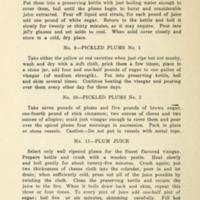43 Ways to Save the Wild Plum Crop
Creator
Date
1917
Excerpt
Nature endows or blesses each State or section with an indigenous flora and fauna best suited to that particular soil and climatic conditions.
Applying the above to Alabama, Macon and adjoining counties have been unusually blessed in the quantity, variety and quality of its wild plums. They vary in size from a half to one inch in diameter, and in flavor from sugary sweetness to sour and bitter. In color, from lemon yellow to crimson, scarlet and black, making possibilities for many pleasing combinations for the eye and palate.
I feel safe in saying that in Macon County alone there are many hundred bushels of plums that go to waste every year that there is a full crop, which is almost one year with another.
In a commercial way there is a great opportunity for jam and jelly factories.
No fruit improves with cultivation more satisfactorily than the wild plum; both the size and flavor is improved, and under cultivation some of the yellow and red types compare favorably in size with the Wild Goose and other cultivated varieties of that class.
In comparison with some of the standard fruits of the world as to food and dietetic value, one is at a loss to know why so valuable a fruit has been and is being so sadly neglected and allowed practically to go to waste.
Applying the above to Alabama, Macon and adjoining counties have been unusually blessed in the quantity, variety and quality of its wild plums. They vary in size from a half to one inch in diameter, and in flavor from sugary sweetness to sour and bitter. In color, from lemon yellow to crimson, scarlet and black, making possibilities for many pleasing combinations for the eye and palate.
I feel safe in saying that in Macon County alone there are many hundred bushels of plums that go to waste every year that there is a full crop, which is almost one year with another.
In a commercial way there is a great opportunity for jam and jelly factories.
No fruit improves with cultivation more satisfactorily than the wild plum; both the size and flavor is improved, and under cultivation some of the yellow and red types compare favorably in size with the Wild Goose and other cultivated varieties of that class.
In comparison with some of the standard fruits of the world as to food and dietetic value, one is at a loss to know why so valuable a fruit has been and is being so sadly neglected and allowed practically to go to waste.
Title
43 Ways to Save the Wild Plum Crop
File(s)
43 Ways to Save the Wild Plum Crop cover.jpg
(image/jpeg)
43 Ways to Save the Wild Plum Crop 1.jpg
(image/jpeg)
43 Ways to Save the Wild Plum Crop 2.jpg
(image/jpeg)
43 Ways to Save the Wild Plum Crop 3.jpg
(image/jpeg)
43 Ways to Save the Wild Plum Crop 4.jpg
(image/jpeg)
43 Ways to Save the Wild Plum Crop 5.jpg
(image/jpeg)
43 Ways to Save the Wild Plum Crop 6.jpg
(image/jpeg)
43 Ways to Save the Wild Plum Crop 7.jpg
(image/jpeg)
43 Ways to Save the Wild Plum Crop 8.jpg
(image/jpeg)
43 Ways to Save the Wild Plum Crop 9.jpg
(image/jpeg)
43 Ways to Save the Wild Plum Crop 10.jpg
(image/jpeg)
 An official website of the United States government.
An official website of the United States government.












